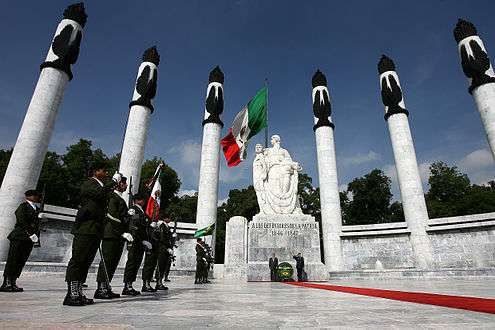Ernesto Tamariz
| Ernesto Tamariz | |
|---|---|
| Born |
Ernesto Tamariz Galicia 11 January 1904[1] Acatzingo, Puebla, Mexico[2] |
| Died | 30 September 1988 (aged 84)[1] |
| Nationality | Mexican |
| Known for | Sculpture |
| Notable work | Memorial to the Mexican cadets killed in the Battle of Chapultepec (Niños Héroes) |
| Movement | Art Deco, Art Nouveau, Eclecticism[2] |
Ernesto Tamariz Galicia (11 January 1904 – 30 September 1988) was a 20th-century Mexican sculptor specialized in public monuments, religious statues and funerary art.[1]
His most famous work is "Altar to the Fatherland" (Altar a la patria), a memorial to the Mexican cadets killed during the Battle of Chapultepec (Niños Héroes). He also sculpted the statue of St Pio of Pietrelcina and John Paul II at the old Basilica of Our Lady of Guadalupe,[3] the new central altar of the Metropolitan Cathedral of Mexico City, the tomb of Alfonso Reyes at the Rotunda of Illustrious People and the tomb of Ignacio Zaragoza,[2] among others.
Works
According to María Estela Duarte, curator of Épica y gloria monumental ("Epic and monumental glory"), a posthumous exposition of Tamariz at the Diego Rivera and Frida Kahlo Museum of Mexico City, the sculptor completed some 128 monuments throughout Mexico.[4]
List of works
- "Altar to the Fatherland" (Altar a la patria), a memorial to the Mexican cadets killed in the Battle of Chapultepec (Niños Héroes).
- Statue of St Pio of Pietrelcina inside the old Basilica of Our Lady of Guadalupe.
- Statue of John Paul II between the old and the new the basilicas of Our Lady of Guadalupe.[3]
- A central altar sculpted in onyx for the Metropolitan Cathedral of Mexico City.
- The tomb of Alfonso Reyes at the Rotunda of Illustrious People.
- The tomb of General Ignacio Zaragoza at San Fernando Cemetery in Mexico City.[2]
- Gallery of selected works
 Memorial to the Mexican cadets killed in the Battle of Chapultepec.
Memorial to the Mexican cadets killed in the Battle of Chapultepec.- Tomb of Alfonso Reyes at the Rotunda of Illustrious People.
- Statue of José Vasconcelos in Mexico City.
References
- 1 2 3 "Exhibirán el legado artístico de Ernesto Tamariz" [The artistic legacy of Ernesto Tamariz will be exhibited]. Conaculta (in Spanish). 5 July 2013. Press release 1033/2013. Retrieved 6 July 2013.
- 1 2 3 4 Palapa Quijas, Fabiola (1 November 2006). "Ernesto Tamariz convirtió a los panteones en espacios artísticos" [Ernesto Tamariz transformed cemeteries into artistic spaces]. La Jornada (in Spanish). Retrieved 6 July 2013.
- 1 2 Zárate Guzmán, Silvia Dolores; Ambrosi de Haro, Ana Paula; Saragoza, Alexander M., eds. (2012). Mexico Today: An Encyclopedia of Life in the Republic. ABC-CLIO. p. 95. ISBN 9780313349485.
The first papal visit took place in 1979, as a result of which a bronze statue of John Paul II was erected between the Old Basilica and the new one. The 19.6-foot-high sculpture was made by Ernesto Tamariz and unveiled in 1981 as part of the celebrations for the 450th anniversary of the apparitions.
- ↑ Ventura, Abida (6 July 2013). "Dedican una retrospectiva al escultor Ernesto Tamariz". El Universal (in Spanish). Mexico City. Retrieved 7 July 2013.
External links
 Media related to Ernesto Tamariz at Wikimedia Commons
Media related to Ernesto Tamariz at Wikimedia Commons